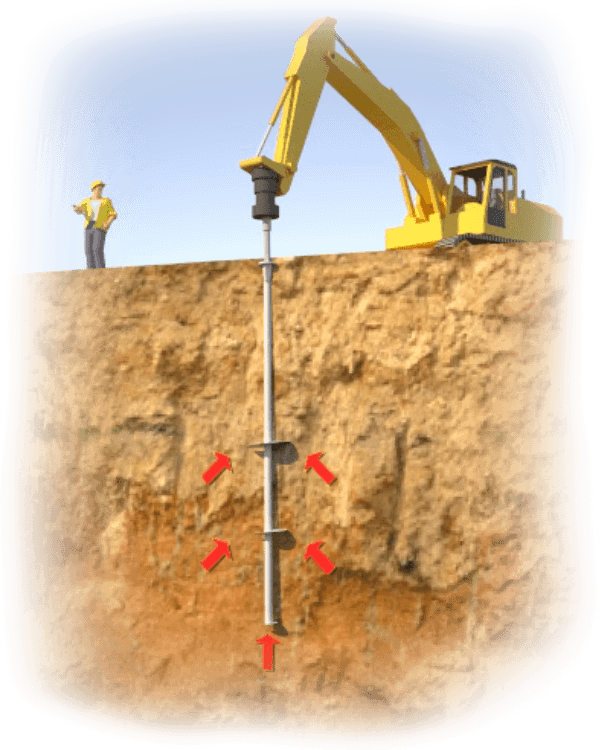Helical piles, also known as screw piles or helical piers, have emerged as a revolutionary foundation solution, offering unmatched stability and versatility in construction projects. These innovative structural elements have gained widespread recognition for their efficiency in providing solid foundations in different soil conditions.
Understanding the Design and Construction of Helical Piles
Helical piles are engineered foundation support systems featuring helical-shaped plates welded to a central steel shaft. This unique design allows for optimal weight distribution and load-bearing capacity. Unlike traditional foundation methods that rely on friction or end-bearing, helical piles utilize the concept of helical blades, which act as screws to anchor securely into the soil. The helical shape allows for enhanced resistance against tension and compression forces, making helical piles an ideal solution for various construction projects.
The Installation Process: Precision and Efficiency

Installing helical piles is a precise and efficient process that minimizes site disruption while ensuring a reliable foundation. Let’s explore the step-by-step installation procedure:
- Site Assessment: We assess the soil conditions before installation to determine the appropriate size and configuration of the helical piles to achieve optimal load-bearing capacity.
- Installation Equipment Setup: We use specialized hydraulic machinery to install helical piles that we configure based on the specific project requirements, ensuring precision during installation.
- Pilot Hole Excavation: A pilot hole is drilled to the required depth using the helical pile’s central shaft. This step ensures accurate placement and alignment of the pile in the soil.
- Helical Pile Installation: Torque-controlled machinery rotates the helical pile into the soil. The helical blades engage with the earth to create a secure foundation. The installation process continues until we achieve our desired depth and load-bearing capacity.
- Verification and Adjustment: We continuously monitor the torque values throughout the installation to verify the load-bearing capacity. We make adjustments to ensure the helical pile meets the engineering specifications.
Applications of Helical Piles in Construction
Helical piles are necessary for various construction projects due to their adaptability and efficiency. Here are some key areas where helical piles have proven invaluable:
- Residential Construction: Helical piles provide a stable foundation for residential structures, whether for new builds or foundation repairs. They are critical in areas with challenging soil conditions.
- Commercial Buildings: The versatility of helical piles makes them suitable for supporting the foundations of commercial buildings, ensuring stability and load-bearing capacity in diverse soil types.
- Infrastructure Projects: Helical piles are present in infrastructure projects such as bridges, highways, and retaining walls. Their ability to provide reliable support in challenging soil conditions makes them a preferred choice.
- Renewable Energy Installations: Helical piles offer a robust foundation solution for renewable energy projects, including solar panel installations and wind turbine foundations. Their efficiency in various soil types contributes to the sustainability of these projects.
- Boardwalks and Marine Structures: In coastal and waterfront environments, helical piles provide a reliable foundation for boardwalks, piers, and other marine structures, offering resistance to water-related challenges.
Benefits to Your Construction Project
The adoption of helical piles in construction projects comes with a myriad of benefits, making them a superior choice for foundation support. Let’s explore the advantages that helical piles bring to the table:
- Versatility: Helical piles are applicable in various soil conditions, including clay, sand, and rocky terrain. Their adaptability makes them suitable for differing construction applications.
- Rapid Installation: The installation of helical piles is a swift process that minimizes construction timelines. This efficiency can lead to cost savings and a faster overall project completion.
- Reduced Environmental Impact: Helical piles have a minimal environmental footprint compared to traditional foundation methods. Installing helical piles generates less noise, vibration, and disruption to the surrounding environment.
- Year-Round Installation: Unlike different foundation methods that can be weather-dependent, helical piles can be installed year-round. This flexibility allows for construction projects to progress without weather-related delays.
- High Load-Bearing Capacity: Helical piles offer exceptional load-bearing capacity, making them suitable for supporting heavy structures. Their helical design enhances stability and resistance against both tension and compression forces.
- Cost-Effective: The efficiency of helical pile installation translates to cost savings for construction projects. Reduced labor and equipment usage contribute to overall project affordability.
- Foundation Repair: We can implement helical piles during foundation repair and underpinning of existing structures. They provide a reliable solution for stabilizing foundations that may have experienced settlement or structural issues.
Choosing the Right Helical Piles for Your Project
We must consider various factors when selecting the appropriate helical piles for your construction project. Here are critical aspects to keep in mind:
- Soil Conditions: Understand the soil conditions at your construction site, as different helical pile designs may be more suitable for specific soil types.
- Load-Bearing Requirements: Assess the load-bearing requirements of your structure to determine the appropriate size and configuration of helical piles needed to support the intended loads.
- Engineering Expertise: Consult with experienced geotechnical and structural engineers to ensure that the chosen helical pile design aligns with the engineering specifications of your project.
- Environmental Considerations: Consider the environmental impact of your construction project. Helical piles are often a sustainable choice.
- Local Regulations: Be aware of local building codes and regulations regarding foundation construction. Ensure that the helical pile installation adheres to all applicable standards.
FAQs on Helical Piles
Helical piles, also known as screw piles or helical anchors, are deep foundation elements used to support structures, especially in areas with challenging soil conditions. They consist of a steel shaft with helical-shaped plates (or helices) welded to it, which screw into the ground to provide stability and load-bearing capacity.
We use helical piles in various construction projects, including residential and commercial buildings, bridges, boardwalks, retaining walls, and communication towers. They are instrumental in areas with weak or variable soil conditions where traditional foundation methods may not be suitable.
Some advantages of helical piles include:
– Installation is quick and efficient.
– Minimal disturbance to surrounding areas during installation
– We can install helical piles in tight or limited-access spaces.
– Provide immediate load-bearing capacity.
– Suitable for a wide range of soil conditions
We install helical piles using hydraulic machinery that applies torque to screw the piles into the ground. The installation involves rotating the helical plates into the soil while monitoring the torque and depth to ensure proper installation and load-bearing capacity.
Several factors, including the structural load requirements, soil conditions, environmental factors, and site-specific considerations, determine the size and design of helical piles. Engineers evaluate these factors to specify each project’s appropriate diameter, length, and configuration of helical piles.
While helical piles are versatile, their suitability depends on soil type, density, moisture content, and bearing capacity. In some cases, soil testing and analysis may be necessary to determine the feasibility of using helical piles in a particular location.
